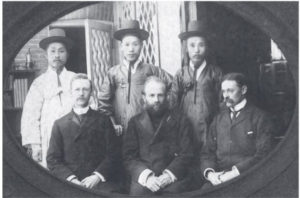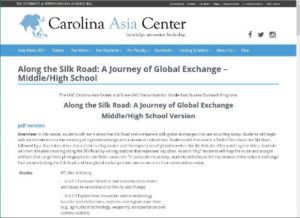Intercultural Contacts 2: Visual Learning, Belief Systems, and the Silk Roads
The term Asia is both, at one level, geographically accurate, and conceptually useful in understanding specific cultures but at another level, the concept of “Asia” is limiting because of regional and global connections that have existed since antiquity. The focus of the January 2021 EAA Digest Exclusive was intercultural contacts, as is the case with this month’s column. Given the subjects most EAA readers teach, understanding the humanities and social sciences means realizing the power of intercultural contacts.
Rachel Ball-Phillips’ “Digital Archives: Teaching Indian Colonial History Through Photographs”(volume 20, number 3, winter 2015) is a short, but useful teaching resources essay whose narrative and photographs assist instructors in understanding mid-nineteenth century colonial India through analyzing both British perceptions of India during this period and viewing a unique historical record compiled at the dawn of photography on the subcontinent. Readers particularly interested in the topic can digitally access a link in the article for many more photographs from the William Johnson Collection archived at Southern Methodist University’s DeGolyer Special Collections Library. Readers interested in comparative cultural content that transcends East Asia can also access the online supplement for the article and examine a course syllabus. Professor Ball-Phillips and her colleague Neil Foley taught a course at SMU that included Mexico and the American Southwest, as well as India.
The late Jean Elliott Johnson’s “China 1905–1908: Harrison Sacket Elliott’s Letters and Photographs” (volume 11, number 3, winter 2006) is probably the best article in the entire EAA archives that combines rare photographs of the last days of the Qing dynasty and masterful integration of primary source excerpts from letters the man who would become her father wrote to his family about his experiences in China. Presuming high school and beginning university students are familiar with rudimentary content on early twentieth century China, this is a superb student reading. Students can read and see a twenty-one-year-old American’s impressions of Chinese culture including commentary on daily life as well as a chronicle of major events like the Boxer Rebellion, and the 1905–1906 government transition from Confucian-based civil service examinations to a more “modern” assessment process. Elliott served for three years as stenographer and aide for the American Methodist Bishop to China.

Historian Donald Clark’s “Americans and the Development of Civil Society in Modern Korea” (volume 19, number 1, spring 2014) focuses upon the role of Americans in helping create civil society in Korea from the latter nineteenth century until the early 1980s, and especially missionary efforts shortly before and after the beginning of the twentieth century that helped empower women and the poor. This selection is also highly recommended as a student reading in several courses because of the author’s accessible prose and balanced treatment of Cold War issues involving civil society before South Korea’s democratic transition. Instructors and students who struggle to understand the relative popularity of Christianity in South Korea compared to other East Asian democracies will find some of the answers in this reading, but learn much more as well about American–Korean relations.
Israeli scholar Shalom Salomon Wald’s “Encounters Between Chinese and Jewish Civilizations” (volume 23, number 2, fall 2018) is a broad, historical, philosophical, religious, educational, and cultural treatment of encounters, mutual perceptions, and comparisons of two of the world’s most resilient civilizations. The essay begins in the tenth century CE and concludes with a discussion that encompasses stereotypes and interests Chinese and Jews hold concerning the “other.” This essay is useful in a variety of subject areas including philosophy, religion, cultural anthropology, and history. The essay’s prose accessibility makes it highly appropriate for honors level high school students and beginning undergraduates.
There are numerous teaching resources on the Silk Roads, but Morris Rossabi’s “The Silk Roads: An Educational Resource” (volume 4, number 1, spring 1999) remains an excellent basic introduction for teachers, especially middle and high school educators who are responsible for teaching pre-twenty-first century history courses and who are unfamiliar with some of world history’s most important transportation routes.
Teachers and students interested in learning about Xi Jinping’s China and who are unaware of the 2013 “Belt and Road Initiative” are urged to read Andy McGreevy’s “Will China Lead the World by Land and Sea? The Belt and Road Initiative” (volume 23, number 3, winter 2018) to learn how the concept of the “Silk Roads” has been redefined in contemporary times.
OTHER TEACHING RESOURCES: The Carolina Asia Center’s Along the Silk Road: A Journey of Global Exchange – Middle/High School

For the uninitiated, a plethora of teaching resources exist on the Silk Roads. That said, the Carolina Asia Center’s Along the Silk Road: A Journey of Global Exchange – Middle/High School is highly recommended for accurate basic content including video clips, maps, and many other resources. Readers who don’t live in North Carolina can skip the state standards, but it is obvious master teachers helped design the unit.
This article was published as part of the May 2021 EAA Digest.

